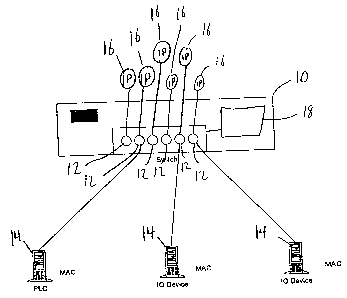Une partie des informations de ce site Web a été fournie par des sources externes. Le gouvernement du Canada n'assume aucune responsabilité concernant la précision, l'actualité ou la fiabilité des informations fournies par les sources externes. Les utilisateurs qui désirent employer cette information devraient consulter directement la source des informations. Le contenu fourni par les sources externes n'est pas assujetti aux exigences sur les langues officielles, la protection des renseignements personnels et l'accessibilité.
L'apparition de différences dans le texte et l'image des Revendications et de l'Abrégé dépend du moment auquel le document est publié. Les textes des Revendications et de l'Abrégé sont affichés :
| (12) Demande de brevet: | (11) CA 2362433 |
|---|---|
| (54) Titre français: | ADRESSAGE DE RESEAU EN FONCTION DU PORT D'UN COMMUTATEUR DE RESEAU |
| (54) Titre anglais: | NETWORK ADDRESSING BASED ON THE PORT OF A NETWORK SWITCH |
| Statut: | Réputée abandonnée et au-delà du délai pour le rétablissement - en attente de la réponse à l’avis de communication rejetée |
| (51) Classification internationale des brevets (CIB): |
|
|---|---|
| (72) Inventeurs : |
|
| (73) Titulaires : |
|
| (71) Demandeurs : |
|
| (74) Agent: | SMART & BIGGAR LP |
| (74) Co-agent: | |
| (45) Délivré: | |
| (86) Date de dépôt PCT: | 2000-12-07 |
| (87) Mise à la disponibilité du public: | 2001-07-12 |
| Licence disponible: | S.O. |
| Cédé au domaine public: | S.O. |
| (25) Langue des documents déposés: | Anglais |
| Traité de coopération en matière de brevets (PCT): | Oui |
|---|---|
| (86) Numéro de la demande PCT: | PCT/US2000/033188 |
| (87) Numéro de publication internationale PCT: | WO 2001050711 |
| (85) Entrée nationale: | 2001-08-30 |
| (30) Données de priorité de la demande: | ||||||
|---|---|---|---|---|---|---|
|
La présente invention porte sur un système d'adressage d'un réseau informatique qui reçoit un message d'un dispositif de réseau et envoie le message réseau vers une destination appropriée. Le commutateur de réseau possède une pluralité de ports de réception et d'envoi de message, ainsi qu'un serveur d'adresse logique qui attribue une adresse logique à un dispositif de réseau en fonction du port du commutateur de réseau auquel est raccordé le dispositif de réseau.
The present invention discloses a network switch for a computer network which
receives a network message from a network device and forwards the network
message to an appropriate destination. The network switch has a plurality of
ports for receiving and forwarding the network message. The network switch has
a logical address server which assigns a logical address to a network device
based upon the port of the network switch to which the network device is
connected.
Note : Les revendications sont présentées dans la langue officielle dans laquelle elles ont été soumises.
Note : Les descriptions sont présentées dans la langue officielle dans laquelle elles ont été soumises.

2024-08-01 : Dans le cadre de la transition vers les Brevets de nouvelle génération (BNG), la base de données sur les brevets canadiens (BDBC) contient désormais un Historique d'événement plus détaillé, qui reproduit le Journal des événements de notre nouvelle solution interne.
Veuillez noter que les événements débutant par « Inactive : » se réfèrent à des événements qui ne sont plus utilisés dans notre nouvelle solution interne.
Pour une meilleure compréhension de l'état de la demande ou brevet qui figure sur cette page, la rubrique Mise en garde , et les descriptions de Brevet , Historique d'événement , Taxes périodiques et Historique des paiements devraient être consultées.
| Description | Date |
|---|---|
| Inactive : CIB expirée | 2022-01-01 |
| Inactive : CIB du SCB | 2022-01-01 |
| Demande non rétablie avant l'échéance | 2004-12-07 |
| Le délai pour l'annulation est expiré | 2004-12-07 |
| Réputée abandonnée - omission de répondre à un avis sur les taxes pour le maintien en état | 2003-12-08 |
| Lettre envoyée | 2002-01-14 |
| Inactive : Page couverture publiée | 2001-12-18 |
| Inactive : Lettre de courtoisie - Preuve | 2001-12-18 |
| Inactive : Notice - Entrée phase nat. - Pas de RE | 2001-12-13 |
| Inactive : CIB en 1re position | 2001-12-13 |
| Demande reçue - PCT | 2001-12-04 |
| Inactive : Transfert individuel | 2001-11-23 |
| Demande publiée (accessible au public) | 2001-07-12 |
| Date d'abandonnement | Raison | Date de rétablissement |
|---|---|---|
| 2003-12-08 |
Le dernier paiement a été reçu le 2002-09-23
Avis : Si le paiement en totalité n'a pas été reçu au plus tard à la date indiquée, une taxe supplémentaire peut être imposée, soit une des taxes suivantes :
Veuillez vous référer à la page web des taxes sur les brevets de l'OPIC pour voir tous les montants actuels des taxes.
| Type de taxes | Anniversaire | Échéance | Date payée |
|---|---|---|---|
| Taxe nationale de base - générale | 2001-08-30 | ||
| Enregistrement d'un document | 2001-11-23 | ||
| TM (demande, 2e anniv.) - générale | 02 | 2002-12-09 | 2002-09-23 |
Les titulaires actuels et antérieures au dossier sont affichés en ordre alphabétique.
| Titulaires actuels au dossier |
|---|
| SCHNEIDER AUTOMATION INC. |
| Titulaires antérieures au dossier |
|---|
| DENNIS J. W. DUBE |
| RICHARD A. BAKER |